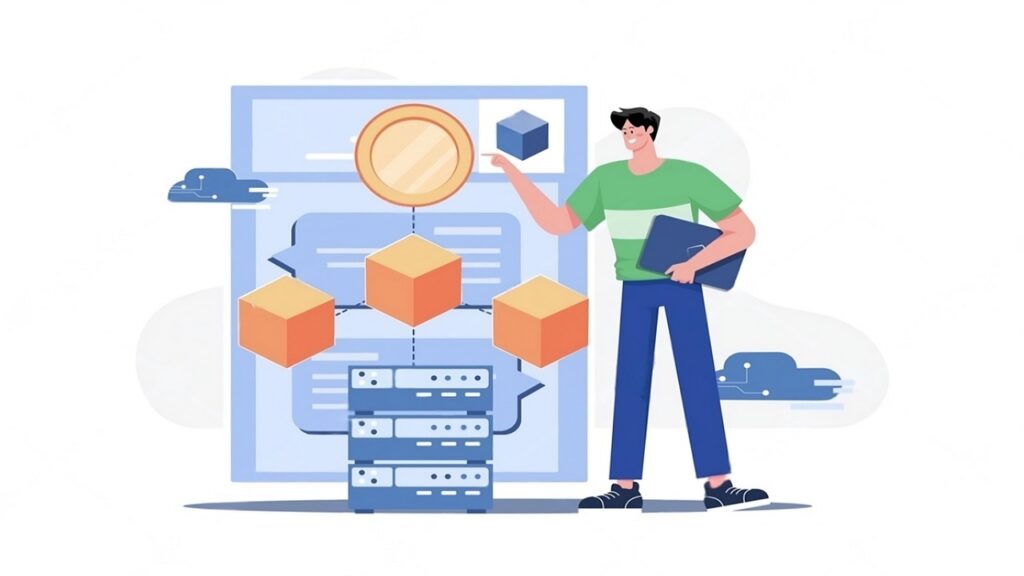
People want trust records, clear ownership and fewer disputes. That is why interest in blockchain application development keeps rising in 2025.
The idea is simple. A shared ledger records events and makes changes hard without agreement. The result is stronger trust across partners.
You can apply the same pattern to payments, supply chains, identity, health data, tickets and more. With the right plan, blockchain app development moves from buzz to real value and steady use.
In this guide, you will learn what the stack looks like, how to pick the right tools and how to create a blockchain app that people can use and trust.
Table of Contents
ToggleWhat is blockchain application development
Blockchain application development is the work of building apps that write facts to a shared ledger and then read those facts to run actions. A fact might be a payment, a shipment scan, a patient consent, a warranty claim or a vote.
Each fact is signed and grouped into blocks. Peers agree on orders through a consensus method. This design makes past entries hard to change without wide approval.
This is not only for coins. Finance teams track settlements. Health teams manage consents with audit trials.
Freight teams trace product lots from origin to store. Education teams issue records that cannot be changed in secret. The same base idea fits many fields where more than one party needs the same source of truth.
Many pilots in supply chains report faster trace time during recalls. Faster trace reduces waste and shortens the time to isolate the problem lot. This is one reason buyers ask for shared ledgers in food and pharma.
Stat: Industry reports in 2024 valued the global blockchain market near nineteen point four billion dollars and projected strong growth through the decade. Teams expect fast expansion in smart contracts, supply chain tracking and financial settlement.
Published case studies in health and insurance show that shared records reduce disputes at audit time. The effect is strongest when events are recorded at each step and when partners join the same ledger with clear rules.
Why interest grows in 2025
Four forces drive adoption.
1. Trust and audit
A signed log help when you must prove steps to regulators, buyers or patients. Carbon tracking, batch trace and consent records all benefit from a clear trail.
2. Automation
Smart contracts run rules without a middle office. They release funds or move assets when terms are met. Work moves forward without email chains.
3. Open ecosystems
Partners can join a network without handing control to one firm. This keeps power balanced and allows rivals to work together on shared processes.
4. Better tools
Cloud nodes, safer wallets and quick access to data make builds faster. You can start small, test value and then scale.
Make a small goal for the first three months. Prove value with one product line or one clinic. Then expand to the next site.
Benefits you can rely on
You want real gains, not hype. These are the benefits teams say matter most.
1. Decentralization
Data is shared across nodes. The network continues if one node fails. This reduces single points of failure.
2. Security
Signatures, hashing and agreement rules protect records. Attackers cannot change the past without consensus.
3. Transparency and trust
Participants can verify events and see the same truth. In a supply chain, each scan becomes part of one story.
4. Immutability
Once a fact is recorded and confirmed, it stays. This helps with audits, compliance and legal checks.
5. Efficiency
By removing many steps and automating rules, teams cut delays and reduce manual review. That frees time for higher value work.
Example: A mid-size food producer logged handoffs from farm to store. When a recall alert hits, the team traced suspect lots in minutes rather than days. Stores removed the right items and avoided broad waste. Customer trust rose the next month.
Start with the right use case
Before any building, ask three simple questions. This habit keeps blockchain application development grounded in value.
- What pain do we solve
Pick a narrow case with clear value. For example, verify warranties, trace organic certification, confirm student hours or track royalty payments. - Who are the actors
List users, partners and external systems. Define who can write to the ledger and who only reads. Decide what each actor is allowed to see. - What must never change
Identify the facts that must be tamper resistant. Write those to the chain. Keep large files off chain and store only their fingerprints to prove they stayed the same.
Choose a platform and network type
Once you know the job, choose a chain. Public chains suit open apps and tokens. Permissioned frameworks suit partner groups that need privacy and tight roles.
Platforms to consider
- You can choose Ethereum for open apps and rich tools.
- You can use Polygon when you want lower fees with Ethereum style contracts.
- You can pick BNB Chain for retail use with fast settlement.
- You can use Hyperledger Fabric for private networks in firms or consortia.
- You can choose Corda for finance flows that need strong privacy between parties.
Network types to consider
Public networks allow anyone to join and verify. Private networks give access only to approved members. Consortium networks share control across several firms. Hybrid designs keep private data inside and post proofs to a public chain.
After the notes above are clear, a compact table helps you compare briefly.
Table 1. Platforms and where they fit
| Platform | Best for | Smart contracts | Access model |
| Ethereum | Open apps and tokens with broad reach | Yes, with Solidity | Public |
| Polygon | Scalable open apps with lower fees | Yes, with Solidity | Public |
| BNB Chain | High volume consumer flows | Yes, with Solidity | Public |
| Hyperledger Fabric | Private workflows and partner rules | Yes, with chaincode | Private or permissioned |
| Corda | Finance agreements with one-to-one privacy | Yes, with CorDapps | Permissioned |
If your app is consumer facing with on chain transfers, choose a public network like Ethereum or a compatible option. If your app is for a group of firms with strict privacy, choose Hyperledger Fabric or Corda.
Design a clear architecture
A strong plan pairs on chain logic with off chain services. This is how blockchain application development stays fast and safe.
On chain logic
Keep rules small and focused. Store only facts that must be shared. Emit events that off-chain services can listen to. Enforce roles and limits in simple steps.
Off chain services
Provide the user interface, keep private files safe and run reports. Store large content off chain and save a fingerprint on chain to prove integrity. Build alerts that react to ledger events.
Data choices
Do not write personal health or private identity details to a public chain. Keep those in your secure store and record a proof on the ledger.
Example: A warranty system records the claim id, product id and a proof of the receipt on the ledger. The full receipt and user details are in a private store. Staff can prove the claim later without revealing personal data.
How to create a blockchain app in steady steps
Teams often succeed when they follow a simple path for blockchain application development.
- Write user stories and define assets
Describe actions like issue, transfer, approve, revoke and expire. Decide who can do each action and what evidence is required. - Model what is on chain and off chain
Choose data that must be shared and immutable. Keep private content in your store. Use fingerprints to link private files to ledger entries. - Pick a toolchain and test network
Choose tools that match your platform. Use a public test network to try flowing end to end with real wallets. - Design roles and permissions
Define what an admin can do, what a partner can do and what a customer can do. Keep roles simple so reviews are faster. - Build a thin interface
Create simple screens that let users write entries and review history. Make the first screen do one job well. - Test, measure, and repeat
Run happy path and error path tests. Measure time to complete tasks and time to fix mistakes. Improve where users struggle. - Plan release and support
Set rules for who can approve changes. Document a pause plan for major issues. Train support staff to answer the top ten questions. - Expand only after proof of value
Add one new feature or one partner at a time. Keep metrics for each change. Growth is easier when each step works first.
If you ask how to create a blockchain product that people trust, the answer is to keep steps small, test with real users and adjust before you scale.
Testing, security and audits
Security is central. A small bug can freeze value or leak data. Treat safety as a shared job across product, security and operations.
Testing that matters
Run unit tests for each rule. Run integration tests on a public test network. Simulate real volume and real errors. Test loss of connectivity and delayed confirmations. Check how your app behaves when fees spike.
Security moves that help
Peer reviews catch many issues. Static checks find risky patterns in on chain logic. External audits reduce blind spots before a public launch. On the app side, apply rate limits for sensitive actions and log every important event.
Now that the ideas are clear, a short table of common risks will help your reviews.
Table 2. Common risks and practical safeguards
| Risk | What can happen | Practical safeguard |
| Reentrancy | A call repeats and drains funds or resources | Update state before external calls and guard entry |
| Weak access rules | A user triggers admin only actions | Use clear roles and test each path with fake users |
| Integer mistakes | Values wrap or break limits | Set sane limits and use safe math in your tools |
| Bad price feeds | Wrong inputs cause loss or pause | Use trusted feeds and take a median from several |
| Signature mix up | A valid signature is used on the wrong content | Bind all fields into the signed message and verify strict formats |
| Key loss | A user cannot recover access | Offer recovery with a waiting period and trusted contacts |
Public audits often highlight role checks and state updates as the top problems. Most fixes are simple once teams expect them.
Keep on chain logic small. Move complex logic to off chain services where you can patch quickly without a network vote.
Operations and compliance
Strong operations turn a good design into a reliable system.
1. Keys and secrets
Keep server keys in hardware modules or managed stores. Rotate keys on a schedule. Limit who can approve releases. Record every approval.
2. Monitoring
Watch transaction success, event flow and user errors. Set alerts for stalled activity, rising fees and unusual patterns. Review logs weekly and after each release.
3. Privacy and data rules
Follow local laws for personal data. In public apps, keep private details off chain. In private networks, collect only what you need and protect it with roles and logs.
4. Backups and resilience
Back up your off-chain stores and configurations. Tests restore procedures. For public chains, your ledger is replicated by design, but your own views and reports still need regular backups.
Write a one-page runbook for people on call. Include steps to pause risky actions, contact details and a checklist for common issues.
Working with blockchain app development services
Some teams build everything in house. Others hire blockchain app development services for speed and safety. The right partner brings experience and helps you avoid early mistakes.
What to look for
- You want a team with live projects in your domain.
- You want deep knowledge of your chosen platform.
- You want a security first mindset and a clear plan for testing and audits.
- You also want help with wallets and identity if your app needs them.
How to qualify a partner
- Ask for a short demo that matches your use case.
- Ask for a plan that shows milestones, risks and test points.
- Ask how they manage keys and who can approve deploys.
Strong answers here save time later.
Note on cost
If you work with blockchain app development services, fees will rise, but time to market often drops. Fewer bugs at launch can also save money that would have gone into emergency fixes.
Cost, timeline and a simple rollout plan
Costs vary with scope. A simple registry for a single product line can be built in weeks. A network with multiple roles, privacy rules and complex reporting can take months.
The main drivers are the number of actions you support, the number of partners you have onboard and your security needs.
A clean rollout follows three stages. First, build a small slice that handles one action well. Second, invite a friendly partner and fix friction you did not see in tests.
Third, open the pilot to more users and gather data on speed, accuracy, and support load. Keep improvements small and steady. This rhythm turns a first win into a wider result.
Scaling after launch
You will need to increase capacity and keep costs under control. You can move high volume traffic to a network with lower fees if needed.
- You can archive old events in your reading models and keep summaries easy to search.
- You can tune confirmation targets to match your risk tolerance.
- You can train support teams to answer common questions and handle recoveries.
Example: A retail program started with three stores and one product. After three months, the team added a second line and invited a supplier.
The data showed faster claim resolution and cleaner returns. The team kept growing one partner at a time and held weekly reviews to keep quality high.
The road ahead
New tools will make it easier to join networks, protect privacy, and prove facts without exposing sensitive data. Managed nodes and safer wallets will reduce setup time.
Clearer rules will help firms roll out with less risk. Training will improve. Templates for common flows will spread across industries.
Final Thoughts
You now have a clear view of blockchain application development and the steps that lead to a working system. The core idea is simple. A shared ledger records what happened and when. That record creates trust between people and firms who do not share a single database.
Choose a small use case, pick a platform that fits, and build a thin first slice. Measure how long tasks take and how often errors occur. Improve what users touch every day. As you learn, expand one step at a time and keep security in focus.
If you need help, choose blockchain app development services with live work in your field and a plan you can read in a page.
With steady effort, blockchain application development will move from pilot to production and deliver value that lasts. Most of all, keep your process simple. That is how to create a blockchain app people trust and use.


